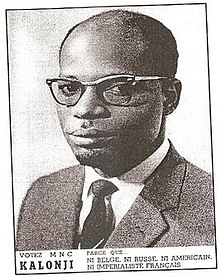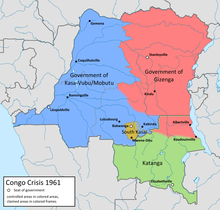Invasion of South Kasai
In early August, Muluba politician Albert Kalonji declared the secession of South Kasai, a region just north of Katanga, with the aim of creating a Baluba-dominated state.
The massacres in Bakwanga provoked international condemnation, with United Nations Secretary General Dag Hammarskjöld commenting that they amounted to "a case of incipient genocide".
A political deadlock ensued, leading ANC Chief of Staff Joseph-Désiré Mobutu to launch a coup and seize control of the central government.
King Leopold II of Belgium, frustrated by his country's lack of international power and prestige, attempted to persuade the Belgian government to support colonial expansion around the then-largely unexplored Congo Basin.
[10] A radical and federalist faction headed by Ileo and Albert Kalonji split away in July 1959, but failed to induce mass defections by other MNC members.
The split divided the party's support base into those who endured with Lumumba, chiefly in the Stanleyville region in the north-east, and those who backed the MNC-K, popular in the south and among Kalonji's own ethnic group, the Baluba.
[15] In Kasai Province, the 1960 elections degenerated into an "anti-Baluba plebiscite" as the Luba MNC-K succeeded in obtaining a plurality but failed to take control of the provincial government.
[17] On 5 July the Léopoldville garrison of the Armée Nationale Congolaise (ANC)—formerly the Force Publique—mutinied in protest of poor working conditions and lack of material advancement following independence, and the revolt quickly spread throughout the Lower Congo.
[25] In New York City the UN Security Council adopted UNSC Resolution 143, calling upon Belgium to withdraw its troops and authorising the Secretary-General to send military and technical assistance to the Congo in consultation with the government to restore law and order.
UN Secretary General Dag Hammarskjöld later stated that these were to form a "temporary security force" that, although acting with the consent of and performing some of the tasks of the government, was completely under UN command.
[32] Those in the former region were to head south into northern Katanga under Sendwe and Minister of Justice Rémy Mwamba to support the local Baluba in waging a guerrilla campaign against Tshombe's government.
[36] The units in the latter area would neutralise South Kasai before heading east and attacking Katanga; one ANC detachment would advance from Luluabourg to Bakwanga and secure the city, while another would move down the rail line and occupy Kaniama.
[43][30] Ghanaian officials in Léopoldville, particularly Ambassador Andrew Djin and General Stephen Otu, warned Lumumba and ANC commanders that an invasion of South Kasai and Katanga would not succeed and that the use of Soviet aid would have severe political consequences.
Despite their advice, Lumumba carried on with preparations for the offensive and, hoping to rally African support behind his decision, continued arranging for the holding of a Pan-African Conference in Léopoldville.
[46] These quickly retreated, though the ANC faced the opposition of local Baluba militia,[44] most of whom were only armed with handmade single-shot rifles called nkonga.
[49] When government troops arrived in Bakwanga, they released Lulua tribesmen from prison,[49] while Lumbala and Omonombe organised the arrest of South Kasaian political figures.
[44][45] Lacking supplies and adequate transportation, ANC soldiers began requisitioning civilian vehicles and seizing food from the locals in preparation for an advance on Katanga.
[38] Gerard Cravatte, the general manager of the Société minière du Bécéka, was detained for five days before being freed on the request of the Luxembourgish consul, as he was a citizen of Luxembourg.
On 31 August some Kalonjist militiamen hiding in a nearby Société minière du Bécéka building opened fire on an ANC column, killing three soldiers.
Ultimately he secured the support he needed to found an army-in-exile consisting of 240[44] to 600 men,[63] most of them recruited from Kasaian immigrant workers in Katanga and led by foreign mercenaries.
[2] The following day ONUC closed all Congolese airports to "civilian"—or non-United Nations—air traffic, with the aim of preventing Lumumba from moving troops into the capital or sending additional forces into Kasai.
[72] Responding to an interpellation concerning the campaign in South Kasai, Lumumba denied that he had ordered any mass killings and blamed the Belgian colonial administration for inflaming the Lulua-Baluba conflict.
Lumumba appealed to them to grant him "full powers" to manage the country's crisis but assured that he was ready to seek an understanding with rival political factions.
[80] On 14 September, Mobutu announced over the radio that he was launching a "peaceful revolution" to break the political impasse and therefore neutralising the President, Lumumba's and Iléo's respective governments, and suspending Parliament until 31 December.
[83] The following day Mobutu, after discussion with UN officials, agreed to terminate the ANC campaign against Katanga and South Kasai, and on 23 September the troops were withdrawn in ONUC aircraft.
[83] "[The actions of the ANC in South Kasai] involve a most flagrant violation of elementary human rights and have the characteristics of the crime of genocide since they appear to be directed towards the extermination of a specific ethnic group, the Balubas [sic]."
Hammarskjöld found the atrocities in South Kasai to be "a case of incipient genocide" and believed that Lumumba, having given the orders to commence the offensive in an "almost casual manner", had lost all sense of responsibility.
Congolese delegates, as well as ANC and ONUC troops were generally able to move around the territory without conflict with the South Kasaian authorities while their sporadic campaign against Katangese forces continued.
[98][99] South Kasai remained in secession until late 1962 when a central government-sponsored military coup overthrew Kalonji and the ANC occupied the territory, allowing for its re-integration into the Congo.
[100] Lumumba's image was unpopular in southern Kasai for years after his death, as many Baluba remained mindful that he had ordered the military campaign that resulted in the atrocities against their people.

